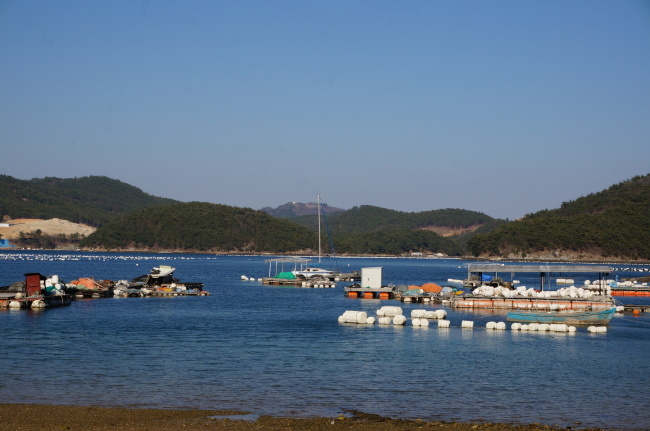Changwon’s spring about more than cherry blossoms
By Lee Woo-youngPublished : April 19, 2015 - 18:32
This is the third installment of a four-part series introducing Korea’s springtime tourist destinations. ― Ed.
CHANGWON, South Gyeongsang Province ― Changwon, a southern industrial port city, heralds the arrival of spring on the Korean Peninsula with cherry blossoms.
The city’s Jinhae district draws huge crowds of tourists and locals with the famed cherry blossom festival Gunhangje every April.
But Changwon is not all about cherry blossoms. A true spring trip comes after the blossoms fall.
This is when spring really sets in on the mountains, shorelines and in the downtown areas. Overshadowed by the cherry blossoms, some of the less-visited places in Changwon reveal the city’s rich history, culture and hidden natural beauty.
Mount Yongdusan in Jeodo Island offers an easy walk around its 200-meter peak. The trail along the Jeodo Beach Road offers breathtaking views of small islets and fish farms dotted in the sea, with 4.3-kilometer and 6.17-kilometer courses. Spring is there along every footstep you take ― in the blooming azaleas, budding flowers and the warm breeze blowing in from the sea.
CHANGWON, South Gyeongsang Province ― Changwon, a southern industrial port city, heralds the arrival of spring on the Korean Peninsula with cherry blossoms.
The city’s Jinhae district draws huge crowds of tourists and locals with the famed cherry blossom festival Gunhangje every April.
But Changwon is not all about cherry blossoms. A true spring trip comes after the blossoms fall.
This is when spring really sets in on the mountains, shorelines and in the downtown areas. Overshadowed by the cherry blossoms, some of the less-visited places in Changwon reveal the city’s rich history, culture and hidden natural beauty.
Mount Yongdusan in Jeodo Island offers an easy walk around its 200-meter peak. The trail along the Jeodo Beach Road offers breathtaking views of small islets and fish farms dotted in the sea, with 4.3-kilometer and 6.17-kilometer courses. Spring is there along every footstep you take ― in the blooming azaleas, budding flowers and the warm breeze blowing in from the sea.

The Jeodo Bridge linking the land and the island is an unexpectedly romantic place. Nicknamed “the Bridge on the River Kwai,” derived from its resemblance to the infamous bridge from the film, the 170-meter bridge, built in 1987, has padlocks of couples locked onto its fences as a symbol of their love.
Old downtown revived
In 2010, three historic cities, Masan, Jinhae and Changwon, merged and became today’s Changwon, the largest city in the province.
Long before the merger, the old downtown of Masan, then a city in its own right, was on steady decline. The abandoned shops and houses became hubs of criminal activity, threatening the safety of the neighborhood. In response, a plan for Changdong Art Town emerged with a goal of reviving the old town through the power of art.
The old downtown area is now the largest cluster of art studios in town. The town still has historical eateries and bakeries running for generations such as Koryodang Bakery, one of the oldest bakeries in Changwon. You can plan your own tour inside the art town, but the route from the Moonshin Art Museum, located on top of a hill, offers a nice, smooth stroll that helps you understand the area’s rich history.
The Moonshin Art Museum (055-225-7181) houses works by early modern artist Moon Shin (1923-1995), who was born and raised in Masan. The small museum, designed by the artist, offers a glimpse into the early modern art development of Korea with paintings and sculptures of the late artist.
Down the alley is Gagopa mural village, a small village with some 30 households living on a hill overlooking the port of Masan. The mural project, initiated to prevent the old neighborhood from turning into a slum in 2013, has now turned the area into a popular photo spot for tourists.
All the way down near the port is where the historic downtown of Masan was. The birth of the place dates back to the 1760s when the old Joseon era administration built a tax office that collected farm crops produced in the southern Gyeongsang region. The area flourished since that time, with markets and banks.
The art town is the result of a decade-long effort to revive the old city center of Masan. As the area was left with abandoned stores in 2003, the city government of Changwon decided to turn it into an art village, bringing artists and local craftsmen to work for low rents in the empty stores.
“It really helped the old downtown revive. There are now franchise coffee shops coming in,” said Kim Gyeong-nyun, a local tourist guide. “You can find every genre of art here from painting, crafts, animation and sculpture to music. There are 54 genres of art combined here.”
By Lee Woo-young (wylee@heraldcorp.com)


![[AtoZ into Korean mind] Humor in Korea: Navigating the line between what's funny and not](http://res.heraldm.com/phpwas/restmb_idxmake.php?idx=644&simg=/content/image/2024/04/22/20240422050642_0.jpg&u=)
![[Exclusive] Korean military set to ban iPhones over 'security' concerns](http://res.heraldm.com/phpwas/restmb_idxmake.php?idx=644&simg=/content/image/2024/04/23/20240423050599_0.jpg&u=20240423183955)



![[Graphic News] 77% of young Koreans still financially dependent](http://res.heraldm.com/phpwas/restmb_idxmake.php?idx=644&simg=/content/image/2024/04/22/20240422050762_0.gif&u=)

![[Herald Interview] Why Toss invited hackers to penetrate its system](http://res.heraldm.com/phpwas/restmb_idxmake.php?idx=644&simg=/content/image/2024/04/22/20240422050569_0.jpg&u=20240422150649)




![[Exclusive] Korean military to ban iPhones over security issues](http://res.heraldm.com/phpwas/restmb_idxmake.php?idx=652&simg=/content/image/2024/04/23/20240423050599_0.jpg&u=20240423183955)



![[Today’s K-pop] Ateez confirms US tour details](http://res.heraldm.com/phpwas/restmb_idxmake.php?idx=642&simg=/content/image/2024/04/23/20240423050700_0.jpg&u=)